Mixing Valves: What are they, and when do you need them
NOTE: Always be sure to follow all local plumbing codes for your application.
If you are working on a replacement project you may not need a new mixing valve, but a new renovation likely will as well as the accompanying supply lines. Be sure to consult with qualified, licensed personnel first.
What is a Mixing Valve?
A water temperature mixing valve is a temperature control device specifically designed to transport the supply
of hot and cold water into a mixing chamber to blend. By limiting the hot water temperature supplied to fittings
for fixtures such as sinks to a safer temperature the risk of scalding is reduced.
Typical automatic faucets are not temperature-adjustable on their own unless integrated with a mixing valve.
By installing a mixing valve you can adjust back and forth the amount of cold water into the system.
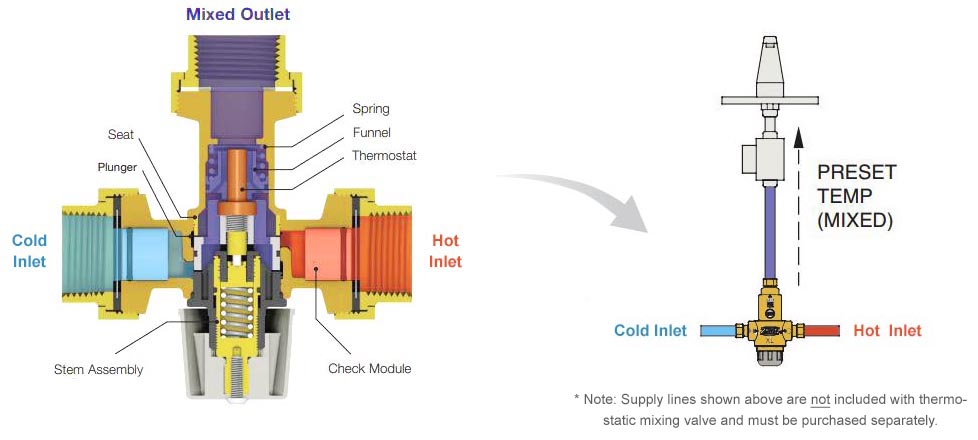
Where is a Mixing Valve used?
Typical applications for mixing valves are for the temperature control of domestic hot water distribution loops such as sinks, tubs, showers, and emergency drench equipment. A thermostatic mixing valve is often mandatory for commercial premises such as restaurants, nursing homes, pre-schools and hospitals.
These scald protection devices are crucial in homes with young children, the elderly and physically challenged individuals as well - but are recommended for every home and may be code in some areas. While taking proper caution is always first with regards to scald prevention, scald protection devices help to maintain a safe water temperature. This allows the user to set their water heater at a high enough temperature to kill bacteria (the standard is 140° F for water heaters) while eliminating concerns of the water being too hot at the faucet.
Why is a Mixing Valve needed?
Hot water is typically stored at 140°F in order to kill Legionella bacteria.
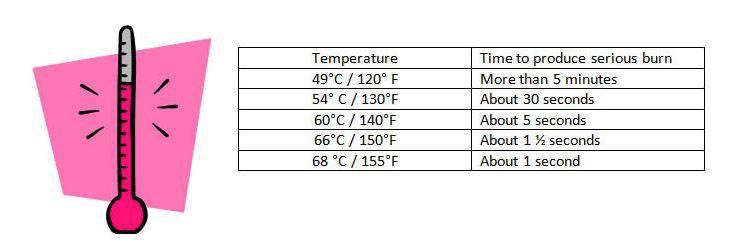
This is too hot to be delivered to the end user, and therefore, it must be mixed with cold water to deliver safe, tempered water.
Health and Safety Code § 113953 (c) - Handwashing water temperature shall be set to at least 100°F, but not greater than 108°F.
Manual “Tempering” Mixing Valve Vs. Thermostatic Mixing Valve (TMV)
A manual (or "mechanical") mixing valve often simply called a “tempering” valve (despite TMV’s also being tempering valves) does not respond to changing conditions on its own. This valve must be adjusted by the building occupant to obtain the desired temperature and is typically set twice a year (during and after the heating season).
In a TMV, the temperature must be set by qualified, licensed personnel. The TMV element inside responds to thermal activity and alters the levels of hot and/or cold water to ensure the set temperature. Set temperature is achieved during installation by removing the cap on the TMV and adjusting the spindle (typically) counter-clockwise to increase the temperature and clockwise to reduce the temperature and then reading the temperature with a thermometer.
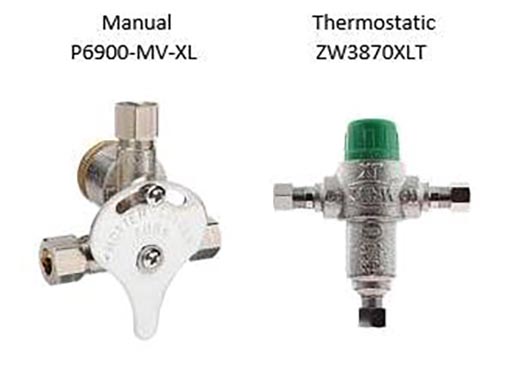
Plumbing Code (ASSE 1070 & UPC Section 407.3)
ASSE is the American Society of Sanitary Engineering, an industry accredited standards developer and
product certification body. The main certification/standard regarding blending hot and cold water in
domestic water systems is ASSE 1070 - Water Temperature Limiting for Devices Sinks,
Lavatories and Baths.
Standard ASSE 1070 calls for devices that limit water temperature
(120° F maximum) to a fixture or fixtures such as sinks, lavatories, or bathtubs to reduce the risk
of scalding. In order to conform:
- Valves must be thermostatic
- Valves must provide scald protection at the rated flow rate of the fixture
- Faucets can have an integrated thermostatic design or water can be tempered using
an add-on valve - The valve must be set to deliver a maximum water temperature of 120°F or less
2021 Uniform Plumbing Code – Chapter 4 – Plumbing Fixtures (407.3)
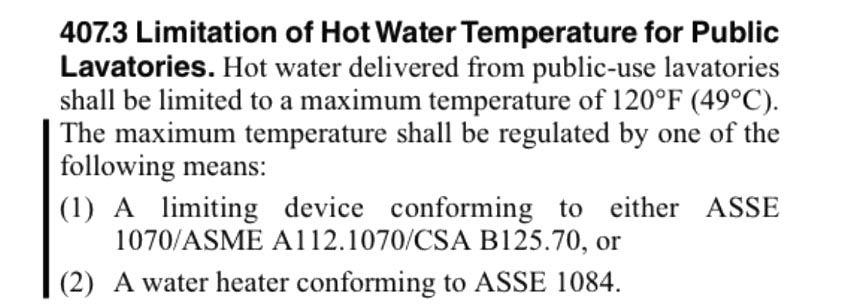
3-Port Mixing Valve Vs. 4-Port Mixing Valve
A 3-Port configuration is for use with touchless sinks where the water is pre-mixed to
the appropriate temperature before entering the faucet.
A 4-Port configuration
is used for faucets that have a hot and cold handle to control the temperature manually.
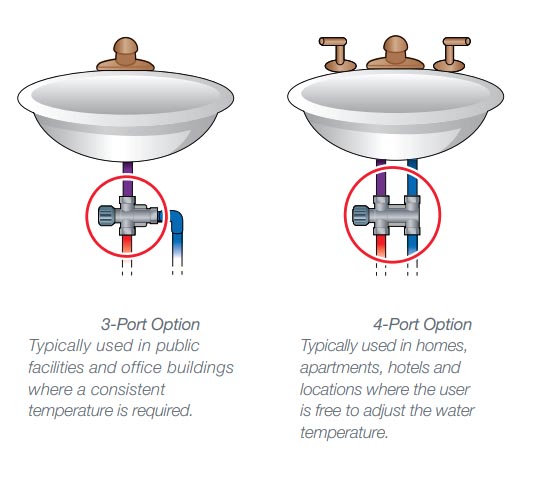
Aerated Flow Vs. Laminar Flow Faucet Outlets
Aerated flow outlets pull air and mix with the water as the faucet is dispensing, giving a more rigid, whiter stream of water that is soft to the touch and non-splashing. They are the usual choice in residential applications.
Laminar flow outlets distribute water from the faucet without absorbing air first (pure). This gives the flow a clear, stream-like pattern, and prevents potential bacteria or germs in the air from getting pulled into the water supply as the faucet is distributing water. Laminar flow outlets are often specified in healthcare and education applications.
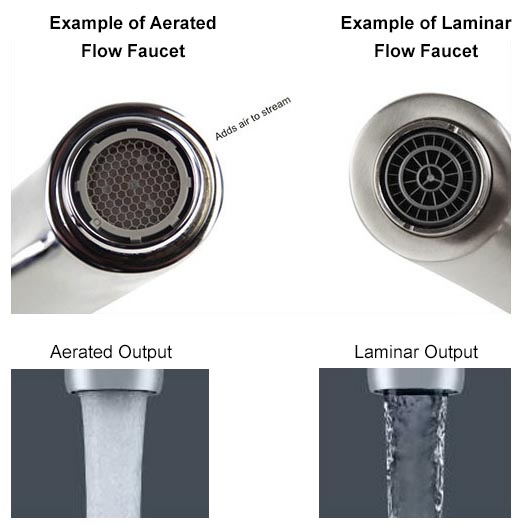
ADA Criteria (Chapter 6: Plumbing Elements and Facilities)
606.4 Faucets: Controls for faucets shall comply with 309 (Operable Parts). Hand-operated metering faucets
shall remain open for 10 seconds minimum.
309.4 Operation: Operable parts (on manual faucets)
shall be operable with one hand and shall not require tight grasping, pinching, or twisting of the wrist.
The force required to activate operable parts shall be 5 pounds maximum.
To help you further, each product in our wide selection of Automatic (touchless) Faucets is notated with whether or not a mixing valve and/or the necessary supply lines are included.
For more information on specific faucets, valves, and other plumbing products, please call us at (704) 937-2673, or email info@berls.com and we will be happy to help you!
<< Back to Resource Center
